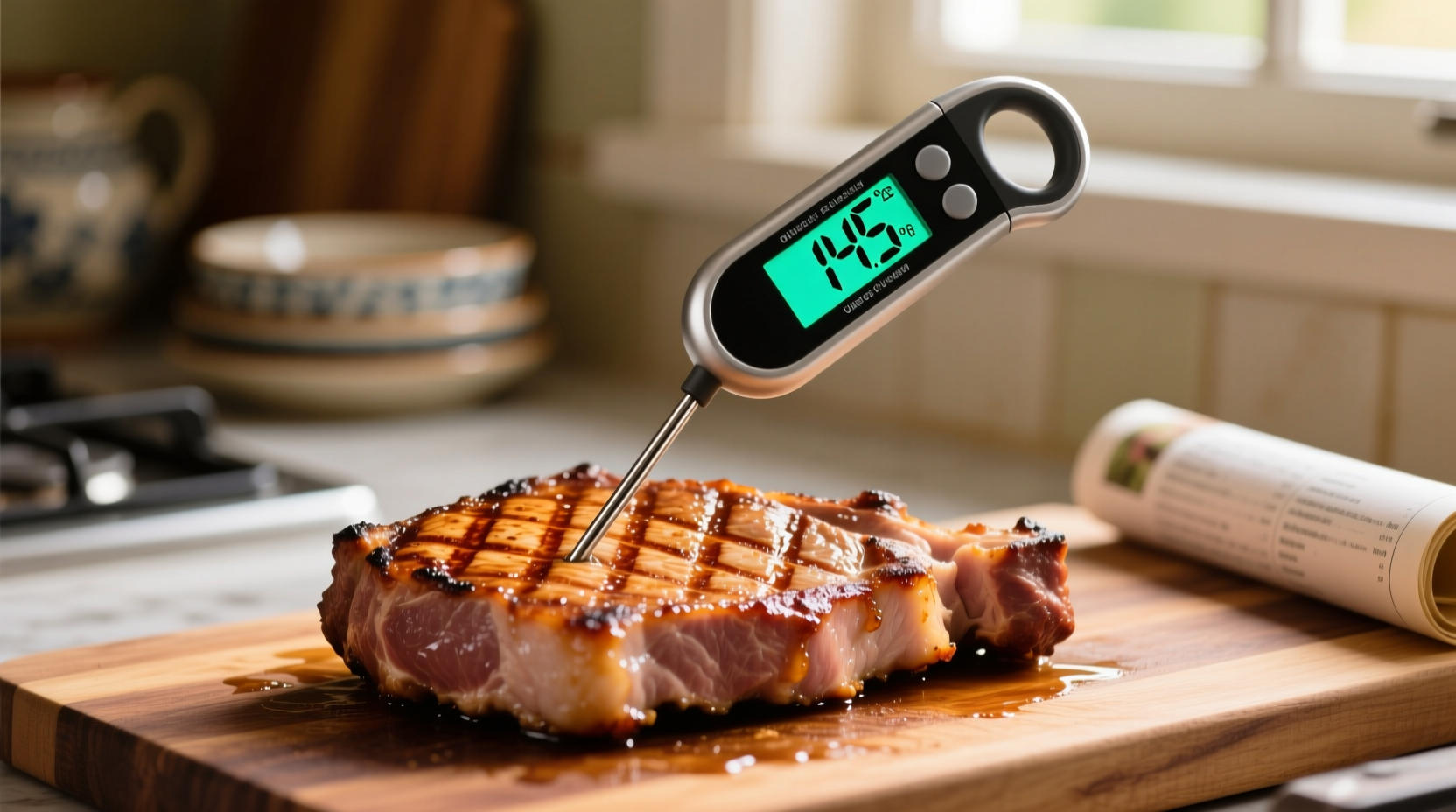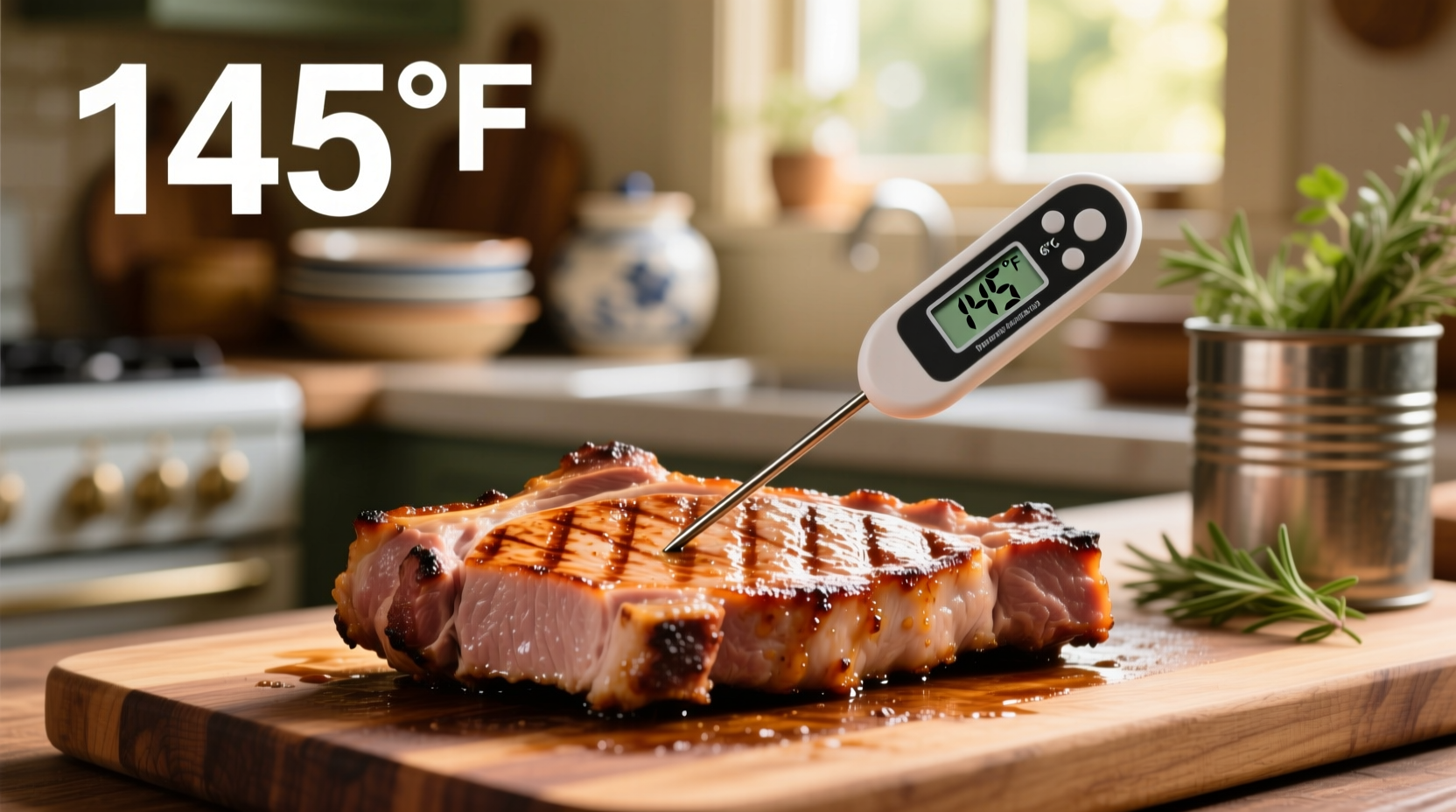Getting pork temperature right isn't just about doneness—it's critical for food safety while preserving that perfect juicy texture. Modern food safety standards have evolved significantly from the old 160°F rule you might remember, thanks to improved farming practices and better understanding of pathogens.
Why Pork Temperature Matters More Than You Think
Contrary to popular belief, properly cooked pork shouldn't be gray and dry. The USDA updated its recommendations in 2011 after extensive research showed that 145°F with a 3-minute rest time effectively kills Trichinella spiralis and other pathogens while maintaining optimal texture. This change reflects decades of improved pork production standards that have virtually eliminated trichinosis in commercial pork in the United States.
| Pork Cut Type | Safe Minimum Internal Temperature | Rest Time | Source |
|---|---|---|---|
| Whole muscle cuts (chops, roasts, tenderloin) | 145°F (63°C) | 3 minutes | USDA FSIS |
| Ground pork | 160°F (71°C) | None required | USDA FSIS |
| Pre-cooked ham (to reheat) | 140°F (60°C) | None required | USDA FSIS |
The Science Behind Perfect Pork Temperature
Understanding the temperature journey of pork helps you become a more intuitive cook. As pork heats, several critical transformations occur:
- 120-130°F (49-54°C): Collagen begins breaking down, but meat remains very rare
- 130-140°F (54-60°C): Myoglobin denatures, changing color from red to pink
- 140-145°F (60-63°C): Optimal range for whole-muscle pork—safe, juicy, with slight pinkness
- 150°F+ (66°C+): Rapid moisture loss begins, leading to dryness
This temperature evolution explains why the old recommendation of 160°F often resulted in overcooked, dry pork. Modern guidelines balance safety with quality, recognizing that pathogens are eliminated at lower temperatures when held for appropriate times.

How to Measure Pork Temperature Correctly
Many home cooks make critical errors when checking pork temperature. Follow these professional techniques:
- Use the right thermometer: A digital instant-read thermometer (like ThermoPop) provides accuracy within ±0.5°F
- Insert properly: Place the probe into the thickest part of the meat, avoiding bone, fat, or gristle
- Check multiple spots: Especially for irregular cuts like shoulder roasts
- Allow for carryover cooking: Temperature will rise 5-10°F after removal from heat
- Verify rest time: The 3-minute rest allows both temperature stabilization and juice redistribution
Special Considerations for Different Pork Cuts
Not all pork is created equal when it comes to temperature requirements. Different cuts have unique characteristics that affect ideal cooking temperatures:
- Pork tenderloin: Best at 140-145°F—this lean cut dries out quickly above 145°F
- Pork shoulder (for pulled pork): Requires 195-205°F to break down connective tissue
- Pork belly: Ideal at 190-200°F for perfect crispiness and tenderness
- Ground pork: Must reach 160°F throughout due to potential pathogen distribution during grinding
The USDA's Food Safety and Inspection Service maintains that 145°F with 3-minute rest is safe for whole-muscle pork because this combination effectively destroys pathogens while preserving quality. This recommendation is supported by the American Meat Science Association's research on thermal destruction of foodborne pathogens.
Common Temperature Mistakes and How to Avoid Them
Even experienced cooks sometimes fall into these temperature traps:
- Mistake: Relying on color alone to determine doneness
Solution: Always use a thermometer—pH levels and cooking methods affect color - Mistake: Not accounting for carryover cooking
Solution: Remove pork from heat 5°F below target temperature - Mistake: Checking temperature too frequently
Solution: Limit thermometer insertions to 2-3 times to prevent juice loss - Mistake: Using oven temperature as indicator
Solution: Oven thermometers often differ significantly from actual oven temperature
Temperature Timeline: How Pork Cooking Standards Have Evolved
Pork cooking recommendations have changed dramatically as food safety has improved:
- Pre-1980s: No standardized recommendations—cooks relied on visual cues and experience
- 1980s-2011: USDA recommended 160°F for all pork to eliminate trichinosis risk
- 2011: USDA updated guidelines to 145°F with 3-minute rest based on improved farming practices
- Present day: 145°F standard widely accepted, with growing understanding of different temperature needs for various cuts
This evolution reflects significant improvements in pork production. According to the CDC, trichinellosis cases in the United States have dropped from about 400 annually in the 1940s to fewer than 20 cases per decade today, largely due to feed regulations and improved farming practices.
Practical Temperature Tips for Perfect Pork Every Time
Implement these professional techniques in your kitchen:
- Calibrate your thermometer monthly using ice water (32°F) or boiling water (212°F)
- Let meat come closer to room temperature before cooking for more even heating
- Use the touch test as a secondary indicator—145°F pork should feel similar to the base of your thumb when making an OK sign
- For large roasts, calculate cooking time based on 15-20 minutes per pound at 325°F, but always verify with thermometer
Remember that altitude affects cooking temperatures—at elevations above 3,000 feet, you may need to increase cooking time by 25% while maintaining the same target temperature. The FDA Food Code provides specific guidance for high-altitude cooking considerations.
When to Adjust Standard Temperature Guidelines
While 145°F is the standard, certain situations warrant temperature adjustments:
- Immunocompromised individuals: Consider cooking to 150°F for extra safety margin
- Commercial food service: Some health departments maintain 150°F requirements
- Smoking or slow cooking: Lower temperatures (225-250°F) require longer cooking to reach safe internal temperatures
- Leftover reheating: Must reach 165°F according to USDA guidelines
For sous vide cooking, the National Center for Home Food Preservation recommends holding pork at 140°F for 22 minutes or 145°F for 12 minutes to achieve pasteurization while maintaining optimal texture.











 浙公网安备
33010002000092号
浙公网安备
33010002000092号 浙B2-20120091-4
浙B2-20120091-4